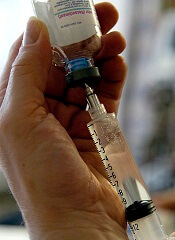
The source of factor VIII (FVIII) replacement therapy affects the risk of inhibitor development in previously untreated patients with severe hemophilia A, according to the SIPPET study.
The data indicated that receiving recombinant FVIII (rFVIII) is associated with a nearly 2-fold higher risk of developing inhibitory alloantibodies than receiving plasma-derived FVIII.
Flora Peyvandi, MD, PhD, of Angelo Bianchi Bonomi Hemophilia and Thrombosis Center in Milan, Italy, and her colleagues reported this discovery in NEJM.
Dr Peyvandi previously presented results from the SIPPET at the 2015 ASH Annual Meeting.
The study included 251 patients (all males) who were younger than age 6 at enrollment. They had severe hemophilia A, negative inhibitor measurement at enrollment, and no or minimal exposure (less than 5 exposure days) to blood products.
The patients were randomized to either a single plasma-derived FVIII product containing von Willebrand factor (n=125) or a single rFVIII product (n=126). The treatment was at the discretion of the local physician.
Confounders—such as family history, previous exposure, and surgery—were equally distributed between the treatment arms. The same was true for the treatment type—on-demand, standard prophylaxis, etc.
Patients were treated for 50 exposure days, 3 years, or until inhibitor development. They were assessed every 3 to 5 exposure days in the first 20 exposure days, then every 10 exposure days or every 3 months and every 2 weeks during prophylaxis.
Results
The primary outcome was any FVIII inhibitor at titers ≥ 0.4 BU/mL. High-titer inhibitors (≥ 5 BU/mL) were a secondary outcome. Transient inhibitors were defined as those that spontaneously disappeared within 6 months.
Overall, 76 patients developed inhibitors, for a cumulative incidence of 35.4%. Fifty patients had high-titer inhibitors, for a cumulative incidence of 23.3%.
The cumulative incidence of all inhibitors was 44.5% (n=47) in the rFVIII arm and 26.8% (n=29) in the plasma-derived FVIII arm. The cumulative incidence of high-titer inhibitors was 28.4% (n=30) and 18.6% (n=20), respectively.
More than 73% of all inhibitors were non-transient in both arms.
By univariate Cox regression analysis, rFVIII was associated with an 87% higher incidence of inhibitors than plasma-derived FVIII (hazard ratio [HR]=1.87). And rFVIII was associated with a 69% higher incidence of high-titer inhibitors (HR=1.69).
A previous study published in NEJM in 2013 suggested that second-generation, full-length FVIII products are associated with an increased risk of inhibitor development when compared to third-generation FVIII products.
So Dr Peyvandi and her colleagues stopped using second-generation FVIII products during the course of the SIPPET study. And they adjusted their analysis to ensure their observations were not due to any confounding effects of the products.
After excluding second-generation, full-length rFVIII from their analysis, the researchers still observed an increased risk of inhibitor development with rFVIII. The HRs were 1.98 for all inhibitors and 2.59 for high-titer inhibitors.


